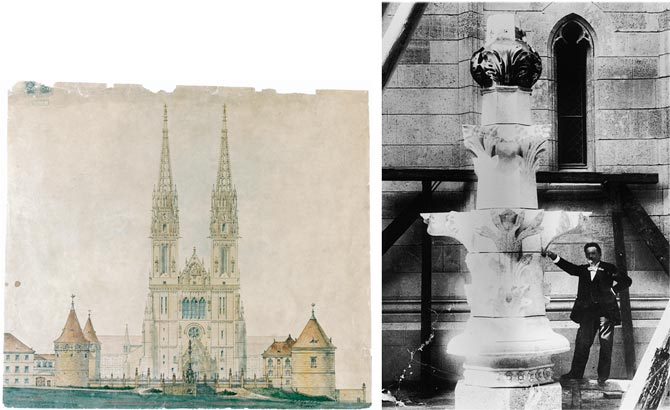Permanent Display 15. The Restoration of the Cathedral by Bollé
 Even when the Cathedral did begin to be renovated, a process begun by Bishop Aleksandar Alagović at the beginning of the 19th century, and continued by Bishop Juraj Haulik (the Neogothic main altar and other details), with a series of other less considerable historicist details during the century, no really significant changes were made until the 1880s.
Even when the Cathedral did begin to be renovated, a process begun by Bishop Aleksandar Alagović at the beginning of the 19th century, and continued by Bishop Juraj Haulik (the Neogothic main altar and other details), with a series of other less considerable historicist details during the century, no really significant changes were made until the 1880s.
The prebend and historian Ivan Krstitelj Tkalčić considered that “the face of the cathedral today is seriously disfigured, what with natural disasters, domestic wars, and finally by the corrupted taste that from the beginning of the 17th century damaged monumental buildings” in France, Italy and Germany, and so, of course, in Croatia.
Stimulated by Tkalčić’s thinking, Bishop and Cardinal Josip Mihalović embarked resolutely on the renovation of the Cathedral, entrusting it to the most renowned expert, the professor of architecture in Vienna Fridrich von Schmidt. Because, however, Schmidt was too busy, the actual work of building was confided to his pupil Herman Bollé. The earthquake that struck Zagreb in 1880, and seriously damaged the Cathedral, meant that the planned renovation could not be put off any longer. In 1885, the most important works inside the structure were done; the baroque vault on the chancel was knocked down, the built-in Gothic windows were opened up, a great deal of the furnishings were removed.

In 1887, scaffolding was put up for the restoration of the western facade. Two high towers were erected, which gave a powerful visual identity to the expanding city. Bollé provided the towers with a fantastic bestiary, hardly visible to the eye, together with a lot of floral elements on the finials and other decorative elements. In March 1902 the renovation was complete. So that the Cathedral could be seen in its new dimensions, in 1906 the old fortress walls and Bakačeva Tower were removed. Bollé’s renovation of the cathedral was based on an idealization of the medieval period, in line with and appropriate to thinking about building current in Europe.
Slavko Šterk

